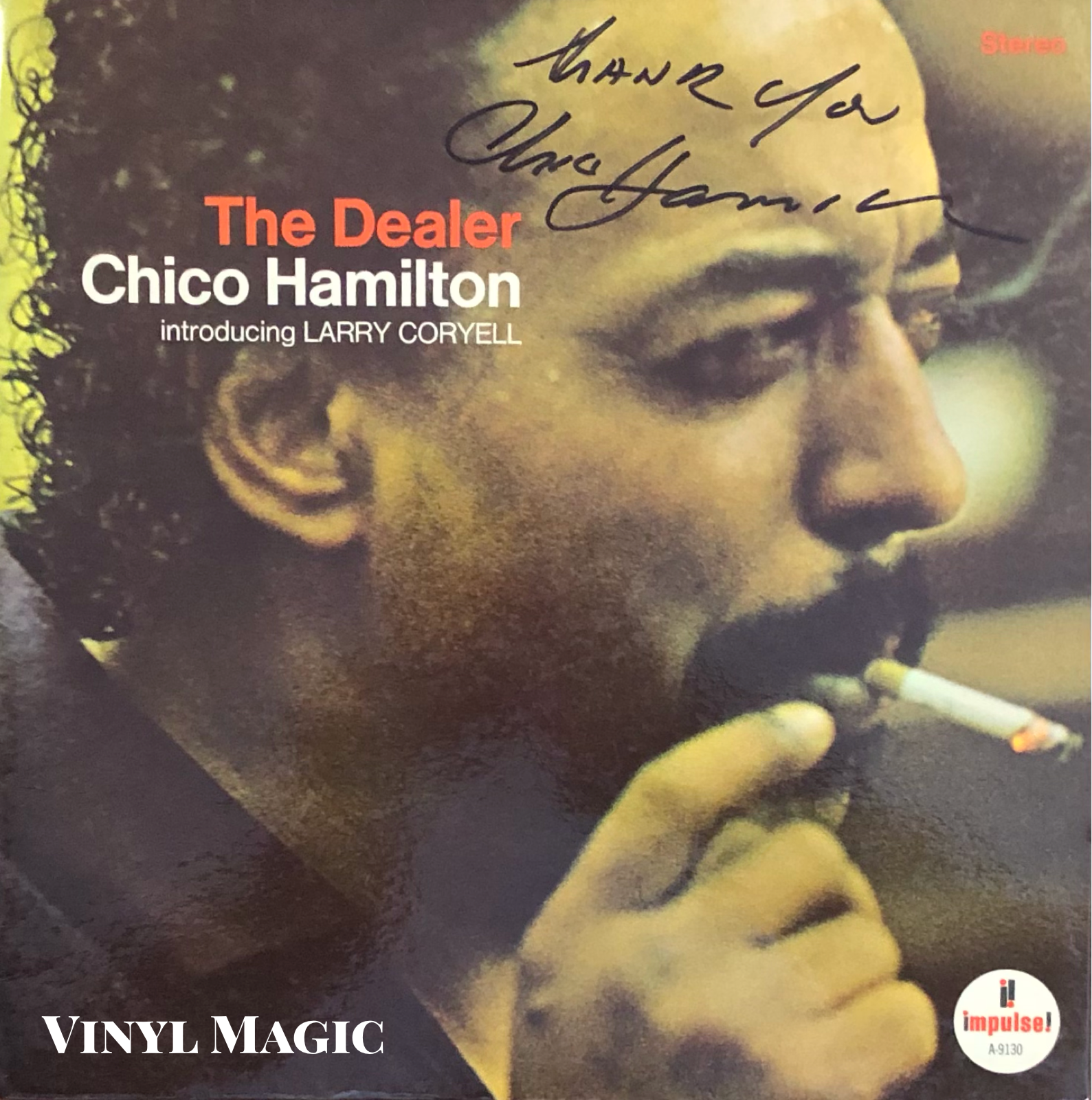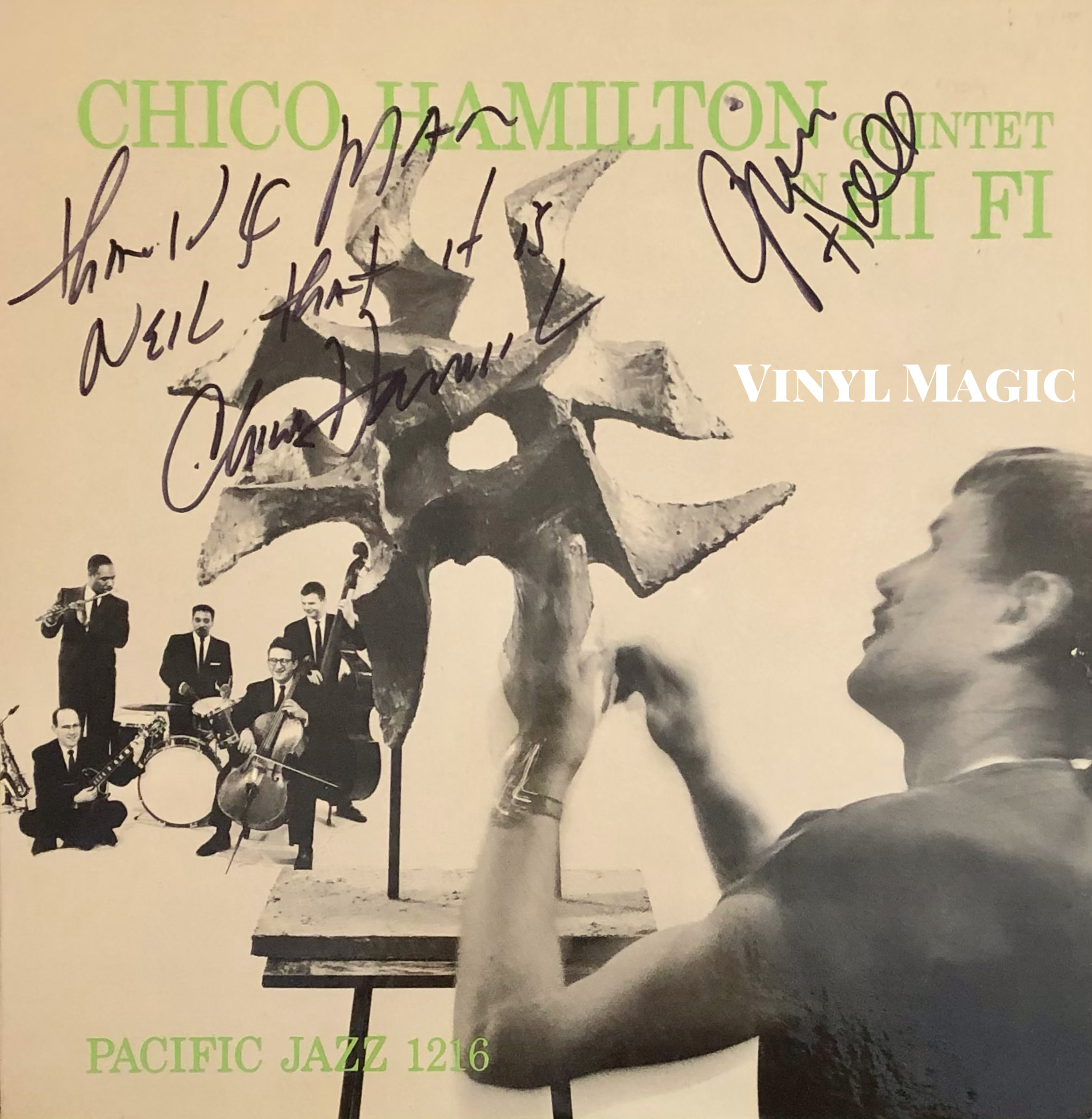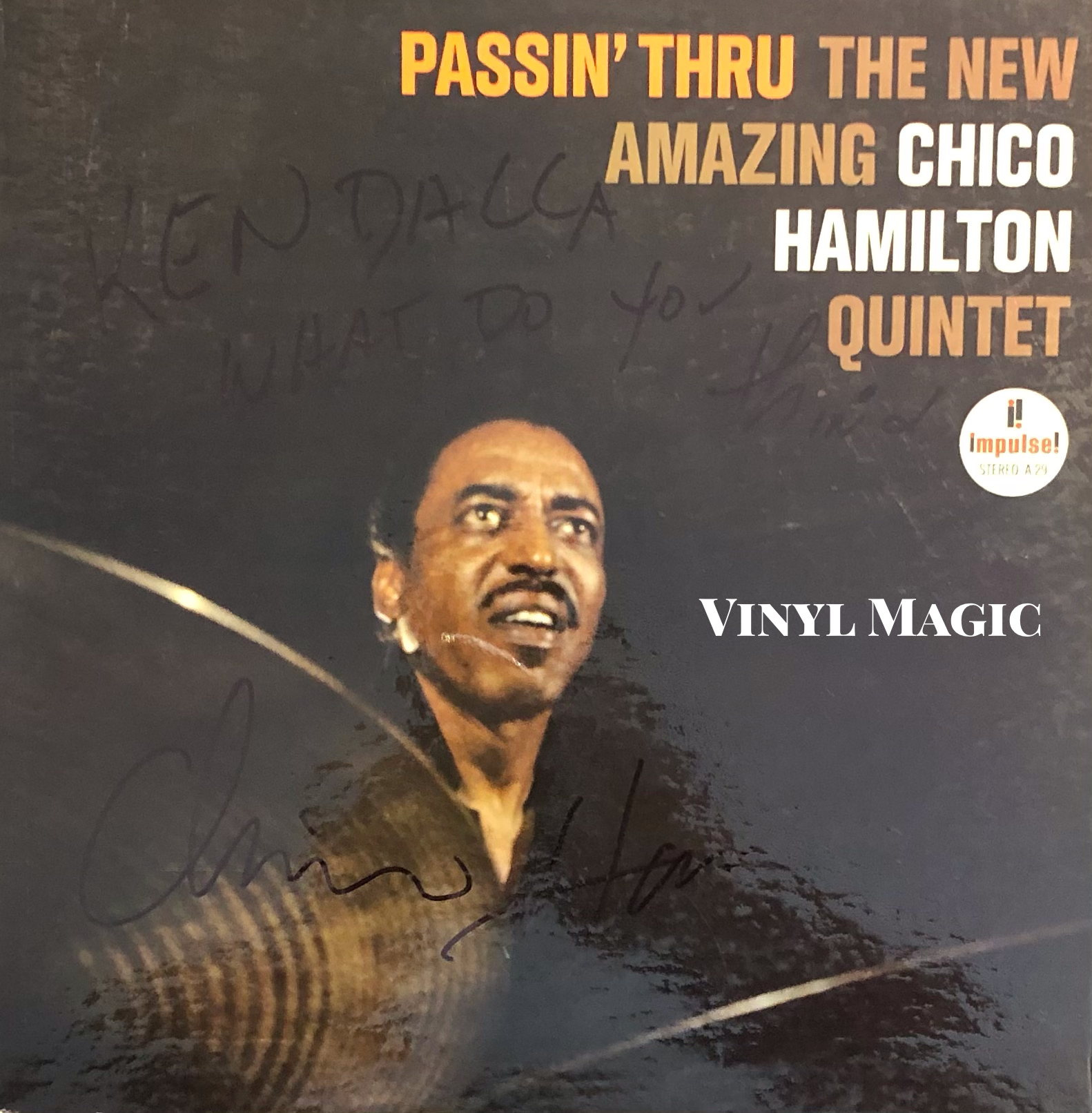Chico Hamilton and Me…
Well, when I was around eight years old, my mother took me to the Paramount Theater to see Duke Ellington, and that's when the band was set up in a pyramid. Sonny Greer, who was the drummer, was set up at the top of the whole pyramid and he had a zillion drums. I was impressed with him and I said, "Hey, that's what I want to do."
Chico Hamilton
With Strings Attached (1959) signed by Chico
I've always seen the drums as a melodic instrument, not a percussive one. I developed a touch, it may not be as loud, but it's mine!
Chico Hamilton
Why not just call it music? That's what it is. Basically,...all we're dealing in is human emotions...and I don't expect you to feel the same way that I do about a note or sound. And it's good that you don't feel the same way, because that way we have an abundance of a variety of emotions. Everybody puts their feelings into a mood and it becomes different, which is dynamite. Because if it all sounds the same, it would be boring as hell...
Chico Hamilton
Meet Chico Hamilton (1957) signed by Chico
Yeah, I've been playing these kinds of grooves for quite a while. Even during the bebop period, I was still playing my kind of thing. I was always a little different from everybody else, and it wasn't easy being different. But it was totally impossible for me to play like Jo Jones, Sid Catlett, Sonny Greer, Max Roach, Art Blakey and people like that. So I had to build my own way of playing.
Chico Hamilton
The Dealer (1966) signed by Chico
First of all, it's totally impossible for two drummers to play alike, because of the physical aspect. One might have long arms, one might have short arms, and if you have short arms, that means that you have to sit closer to your instrument. If you have long arms, you sit back...for reach. And just the space between makes a difference in the sound you're going to get, or the touch you're going to acquire to get the sound. I don't sound like anybody else, and I don't know of anybody who sounds like me. So the old adage, "Hey, give the drummer some", that's the bottom line. But, I don't know, I just do what I do. And Louis Hayes does what he does, Max Roach does what he does, Kenny Clarke does what he does, Jo Jones did what he did, Sonny Greer, all of them....that's how broad and beautiful this whole thing is...
Chico Hamilton
A lot of guys came out of my band, Charles Lloyd, Gabor Szabo, Larry Coryell, I groomed these guys, man, I let them find themselves.
Chico Hamilton
Born in Los Angeles, Foreststorn "Chico" Hamilton is an acclaimed drummer, arranger, band leader, and composer. He released more than sixty-five albums as a leader in his prolific career, which included an appearance in the Sweet Smell Of Success, a 1957 film starring Burt Lancaster and Tony Curtis. In the movie, Chico is a band leader in a New York City jazz club and he also released a soundtrack for the film which featured his quintet of drums, bass, cello, guitar, and flute or saxophone. Dubbed "Chamber Jazz", the Chico Hamilton Quintet was as influential as it was unusual.
Chico attended Jefferson High School in Los Angeles and some of his fellow classmates included tenor saxophone giant Dexter Gordon, Count Basie trumpeter Ernie Royal, and future bandmate and multi-instrumentalist, Buddy Collette. It was a fertile music environment and it remained so when soul icons Barry White and Etta James matriculated at Jefferson years later. And Chico's Hollywood bona fides didn't stop there. His younger brother, Bernie, best known for his role as "Captain Dobey" on the 1970s cop show Starsky & Hutch, started a record label and released an album, Captain Dobey Sings The Blues in 1975. Certainly, no vinyl collection is complete without it!
“Captain Dobey” aka Bernie Hamilton, Chico’s bro
After playing with Lionel Hampton, Count Basie, Lester Young, Gerry Mulligan, and many other jazz legends, Chico did a stint backing up singers, including Sammy Davis Jr., Billy Eckstine, Billie Holiday and nearly eight years with the divine Lena Horne. Chico recounted, "I spent about fifteen years playing for singers, and brushwork was the name of the game, being able to lay down a groove and stay quiet underneath them. Playing for singers, you learn to accompany, which enhances your ability to play behind a horn because you develop a sense of listening and timing. If a horn player does a strange kind of phrase, you're right on it." Then, Chico started his quintet.
He had keen and discerning ears for talent, especially guitar players. Guitarists Jim Hall, Howard Roberts, Gabor Szabo, and Larry Coryell all recorded and toured with the Chico Hamilton Quintet and later enjoyed prominent jazz careers as leaders and composers. And not only jazz guitarists excelled, alto saxophonist Charles Lloyd, multi-reed man Eric Dolphy, trombonist Steve Turre and uber bassist Ron Carter all credit their early sessions in Chico's quintet as seminal experiences in developing their talents.
Man From Two Worlds (1963) signed by Chico
Influential on the West Coast jazz scene, Chico was a role model to jazz and rock and roll drummers. Charlie Watts of the Rolling Stones was an early fan and later traded beats with Chico on "Here Comes Charlie Now", a track from the 2001 release Foreststorn. Chico explained their connection, "My manager saw an interview where Charlie said that when he was a kid, I inspired him to play when he heard me with the Gerry Mulligan Quartet playing "Walking Shoes" with brushes. He said he used to call himself Chico Watts. I met him in New York at Birdland when he came over with his jazz group. He couldn't get over the fact that I came to see him. We became friends, and one thing led to another."
I saw Chico a number of times in the late 1990s in New York City at the Iridium and Birdland. Unlike most jazz or rock drummers, Chico had his drum kit set up at the front of the stage. He had his usual quintet: electric guitar, bass, alto and soprano saxophone. No piano. Chico introduced the innovative piano-less quintet in 1955, and it served his music well through the years. This night, the mix of electric guitar and bass fused with the hard bop of Eric Person's searing alto saxophone. All the while, Chico sat at his drum kit in the front, directing the action, hardly touching his sticks, using mallets and brushes mostly, a swirling and melodic performance by a master percussionist.
El Chico (1965) signed by Chico, “This is the one”
After the shows, I visited with Chico and he signed some of his vinyl from his impressive discography. He was always warm and gracious. "This is one of my favorites," he said as he inscribed El Chico, "This is the one". In the liner notes, he states, "I've always liked Latin rhythms, but I never felt quite ready to try an entire album utilizing the idiom. In the past three or four years, however, I began to pay increasing attention to the essence of the Latin rhythmic approach and to its similarities with jazz. Finally, I felt immersed in the whole Latin feeling and decided to go ahead. But I also wanted to surround myself with the best Latin players available, and that's why Willie Bobo and Victor Pantoja are present." The Latin sound is enhanced by the Eastern European flourishes of guitar extraordinaire Gabor Szabo, a Hungarian by birth, a freedom fighter and émigré by choice.
Chico Hamilton Quintet In Hi Fi (1956) signed by Chico, Jim Hall “Thanks Neil, that it is”
I asked Chico why he never played the Village Vanguard, the finest jazz club in the world with the best acoustics, and the site of many legendary recordings. "Nah, they don't want to hear my shit," he said with a dismissive wave toward his drums and other electric instruments. "They just want straight ahead jazz and my shit is anything but..." We both laughed and I handed him the cover for Chico Hamilton Quintet In Hi Fi, "That was a wild gig, we played our music and the artists were all around making their art." The cover photo by William Claxton, a world renowned photographer, was taken at The Clay Workshop on Beverly Drive in Los Angeles. Vito Paulekas, depicted in the foreground on the album cover, ran the studio for nearly twenty years. Vito, a sculptor, teacher and a bohemian in every sense, was plugged into the art and music scene, and the studio eventually became rehearsal space for sixties icons, The Byrds, Arthur Lee and Love, and several of Frank Zappa's Mothers Of Invention. Vito provided the art and the space, and the musicians provided the tunes, a great symbiosis. Finally, I asked Chico to dedicate an album cover to my daughter, Kendall, who had just celebrated her first birthday. Chico smiled mischievously and handed me back the Passin' Thru cover, "Kendalla, What do you think?"
Passin’ Thru (1983) signed by Chico, “Kendalla, what do you think?”
Chico Hamilton, an influential band leader, composer, and drummer. As he said, "I never try to point too definite a direction. Music is changing all the time because people change, and we try to keep ourselves open to new experiences, new timbres, new ways of feeling music as a unit."
Always changing and challenging, Chico kept the grooves coming.
The Best Of Chico Hamilton (1968) signed by Chico
Choice Chico Hamilton Cuts (per BK's request)
https://www.youtube.com/watch?v=Lx-vsmRSDTw
"Walkin' Shoes" with Gerry Mulligan 1952 Charlie "Chico" Watts favorite!
https://www.youtube.com/watch?v=0BJNxVf_iLM
"Conquistadores" El Chico 1965
One Latin nation under a groove!
https://www.youtube.com/watch?v=xoxTkPFOB9I
"Forest Flower" Man From Two Worlds 1964
https://www.youtube.com/watch?v=D-s4eojiVSc
"People" El Chico with Gabor Szabo on guitar 1965
https://www.youtube.com/watch?v=QzdoWfBAMx8
"Blue Sands" Live at Newport 1958 with Eric Dolphy, John Pisano
https://www.youtube.com/watch?v=saNdX5EESZ0
"Gengis" The Master with Lowell George on slide guitar 1973
https://www.youtube.com/watch?v=90ly2Sgw5c8
"Close Your Eyes" With Strings Attached 1958








